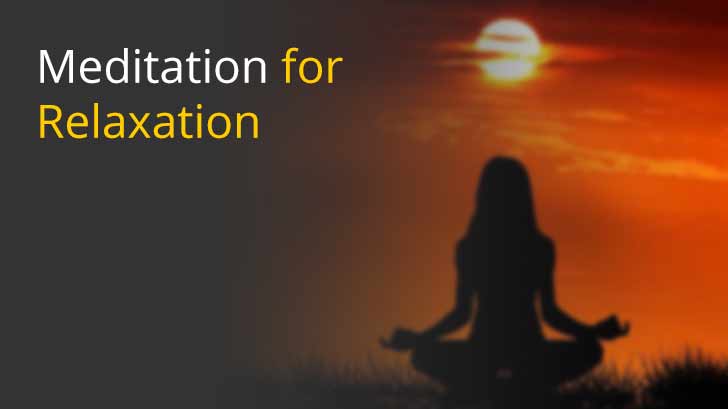- Home
- Meditation
- Relaxation
-
Customer Care 9999 091 091
- Consult Now
-
Notifications
-

Many of us think of relaxation with a massage or rolling ourselves on a comfortable couch after a tiring day at work. But to activate your body’s natural relaxation response you need to effectively combat stress. You need a deep relaxation practice to put a brake on all stress factors to bring your body and mind to balance. A meditation for relaxation technique might do wonders for you.
But, do also keep in mind that not every meditation technique is meant for relaxation. However, there are multiple ways of meditation to achieve relaxation.
Meditation for relaxation typically involves building calm by using an object focus such as your breath, body parts, or visualization, which are effective in managing stress. Stress is an unpleasant and unavoidable part of our daily lives and this surgeon hormone levels can overpower us often taking a toll on our health. Meditation is available to all of us anywhere and anytime. Learning to consciously relax the body and mind through meditation techniques of relaxation can bring us reduced stress, which in turn can lead to the better overall health of mind, body and emotions, and a better quality of life.
1. Progressive Muscle Relaxation
In this meditation technique you systematically tense and relax different muscle groups in the body. With regular practice, it gives you an innate familiarity with that tension as well as complete relaxation in different parts of the body. And as your body relaxes so will your mind.
Before practicing this meditation you need to consult with a doctor first if you have a history of muscle spasms, back problems, or other serious injuries that may be aggravated by tensing muscles.
Begin the practice by starting at your feet and gradually working your way up to your face. Try to tense only those muscles intended. It may take some practice at first, but try not to tense muscles other than those intended. Follow these steps to practice muscle relaxation technique.
Wear loose clothing, take off your shoes and get comfortable.
Take a few moments to breathe in and out in slow, deep breaths.
When you’re ready, shift your attention to your right foot. Take a moment to feel the way it feels.
Slowly tense the muscles in your right foot, squeezing as tightly as you can. Hold or a count from 8-10.
Relax your foot. Focus on the tension flowing away and how your foot feels as it becomes limps and loose.
Stay in this relaxed state for a moment, breathing deeply and slowly.
Now shift your attention to your left foot. Follow the same sequence of muscle tension and release.
Move slowly up through your body, contracting and relaxing the different muscle groups.
2. Deep Breathing meditation
Breathing is a simple yet powerful relaxation technique. And there’s a reason why meditation techniques involve taking long, slow, deep breaths. It’s an incredibly effective and scientifically proven method to relax the mind and body. Through regular deep breathing meditation we can learn to relax when needed.
Follow these steps to practice deep breathing.
Sit comfortably with your back straight.
Place one hand on your chest and the other on your stomach.
Breathe in through your nose. As you breathe, the hand on your stomach should rise. The hand on your chest should move very little.
Exhale deeply through your mouth. Push out as much air as you can while contracting your abdominal muscles. The hand on your stomach should move in as you exhale, and the other hand should move very little.
Continue breathing in through your nose and breathing out through your mouth. Inhale enough so that your lower abdomen rises and falls. Count slowly as you exhale.
If you find uncomfortable breathing from your abdomen while sitting up, you can lie down. You can place a book on your stomach, and breathe to feel it rise and fall as you inhale and exhale.
3. Mindfulness Meditation
Mindfulness path of meditation has long been used to reduce all sorts of negative emotions in people. These practices enable you to be fully engaged in the present moment by focusing your attention on a single repetitive action, such as your breathing or repeating positive words, phrases or mantras.
When our minds and bodies are relaxed through meditation the parasympathetic nervous system is stimulated causing the body to stop releasing stress hormones. This also results in low heart rate, and promotes a sense of calm. Over time, through regular practice of meditation for relaxation, we learn to condition our body and mind to relax on demand.